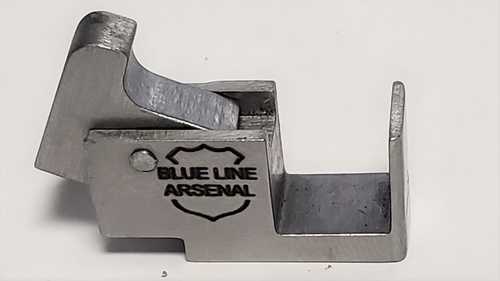Introduction to Drop In Auto Sear
The world of firearms is constantly evolving, and one of the most intriguing components in recent discussions is the Drop In Auto Sear (DIAS). This small but mighty piece has sparked interest among gun enthusiasts and professionals alike. But what exactly makes a DIAS so significant? As law enforcement agencies tighten their grip on sales policies, many are left wondering how this will impact their access to AR-15s equipped with these devices. With changes on the horizon, it’s time to dive into what a Drop In Auto Sear truly means for both seasoned collectors and new gun owners navigating this complex landscape.
Explanation of Drop In Auto Sear (DIAS)
A Drop In Auto Sear (DIAS) is a device designed to convert semi-automatic rifles into fully automatic firearms. It allows for continuous fire with just a single pull of the trigger, significantly increasing rate of fire.
The DIAS is engineered to fit seamlessly within the lower receiver of an AR-15. Its installation requires no permanent modifications, making it appealing to certain firearm enthusiasts looking for enhanced performance.
When activated, the auto sear catches and releases the hammer repeatedly as long as pressure is maintained on the trigger. This functionality transforms standard rifles into rapid-fire weapons in mere seconds.
However, owning or using a DIAS comes with strict legal regulations. This has led to discussions about its availability and impact on gun rights across various communities. The evolving landscape around these devices continues to shape conversations surrounding firearm ownership and regulation.
History of DIAS sales to civilians
The history of Drop In Auto Sear (DIAS) sales to civilians is marked by a complex interplay of regulations and public sentiment. Initially, these devices were relatively accessible, catering to enthusiasts eager for customization options on their AR-15s.
In the early days, many gun owners viewed DIAS as tools for enhancing performance. The allure of converting semi-automatic rifles into fully automatic ones drew significant interest from the civilian market. However, this excitement quickly attracted scrutiny from law enforcement and regulatory bodies.
By the late 1980s, concerns over firearm-related incidents prompted stricter regulations. The ATF began more closely monitoring DIAS transactions. As laws evolved, accessing these components became increasingly challenging for civilians.
This shift reflected broader societal anxieties about gun violence and safety. Over time, what was once seen as an innovative accessory transformed into a contentious topic within both legal frameworks and community discussions surrounding firearms ownership.
Recent changes in sales policies
In recent months, sales policies regarding the drop in auto sear (DIAS) have shifted dramatically. What once was a relatively accessible component for civilian gun owners has now become restricted primarily to law enforcement agencies.
These changes were triggered by increased scrutiny from regulatory bodies and heightened concerns about public safety. The adjustments aim to prevent misuse of DIAS, which can convert semi-automatic rifles into fully automatic firearms.
Manufacturers are now required to vet buyers more rigorously. This includes thorough background checks and proof of employment with law enforcement organizations. Such restrictions not only limit access but also create an atmosphere of uncertainty among consumers who previously had easier pathways to purchase these components.
The implications extend beyond simple availability; they affect the entire supply chain and market dynamics within the firearm industry as businesses adapt to new regulations and consumer demands shift accordingly.
Impact on gun owners and industry
The decision to restrict Drop In Auto Sear (DIAS) sales exclusively to law enforcement has sparked a wave of reactions among gun owners and industry stakeholders. Many feel this limits personal freedom and the right to customize firearms.
For enthusiasts, it changes the game entirely. The thrill of building an AR-15 with advanced components is part of the culture. Losing access to DIAS impacts both creativity and performance potential in firearm modifications.
Gun manufacturers are also feeling the heat. With fewer consumers able to purchase these parts, revenue streams may dwindle. Some companies might pivot their focus toward other products that remain accessible.
Retailers face challenges as well. Stocking items that appeal primarily to law enforcement can limit market diversity. Shifts like these could lead many businesses to rethink their strategies moving forward, navigating a more regulated landscape while trying to meet consumer demands within new constraints.
Arguments for and against the new policy
Supporters of the new policy argue that restricting Drop In Auto Sear (DIAS) sales to law enforcement enhances public safety. They believe it helps prevent these devices from falling into the hands of individuals with malicious intent. This measure could potentially reduce gun violence and accidental discharges.
On the other hand, critics see this move as an attack on Second Amendment rights. They contend that responsible citizens should have access to all firearms accessories, including DIAS components. Limiting sales only to law enforcement may create a perception of government overreach.
Moreover, some argue that such restrictions won’t significantly impact crime rates since criminals often acquire weapons through illegal means anyway. The debate continues as both sides present their perspectives on how best to balance safety and personal freedoms in a changing landscape of firearm regulations.
Conclusion: What this means for the future of AR-15 ownership
The recent shift in the sales policy regarding drop in auto sears has created a significant ripple effect within the firearm community. By restricting sales to law enforcement only, manufacturers and lawmakers have brought forth new discussions about gun ownership rights and public safety.
For many enthusiasts, this change raises questions about accessibility and personal freedoms. The ability to convert an AR-15 into a fully automatic weapon through the use of a DIAS was once seen as part of responsible ownership for some. Now, that avenue is closed off to civilians who may have viewed these components as essential for their collections or intended uses.
On the other hand, advocates of stricter regulations argue that limiting access can ultimately enhance safety measures within communities. They believe that tighter controls could help prevent firearms from falling into the wrong hands. This highlights an ongoing debate between individual rights and collective security.
As we move forward, it will be interesting to see how this policy impacts both current owners and potential buyers of AR-15s. The future landscape of gun ownership might become more focused on compliance with regulatory frameworks rather than unbridled access to modification options like drop in auto sears.
What remains clear is that changes like these will continue influencing not just market dynamics but also conversations around second amendment rights across America. Gun owners must stay informed as policies evolve, understanding their implications on both personal liberties and overall public safety concerns related to firearms.

















